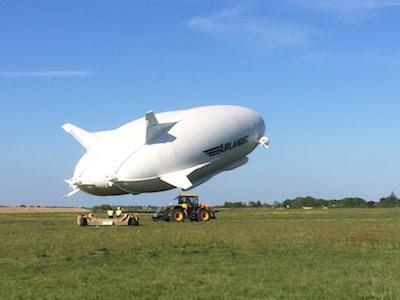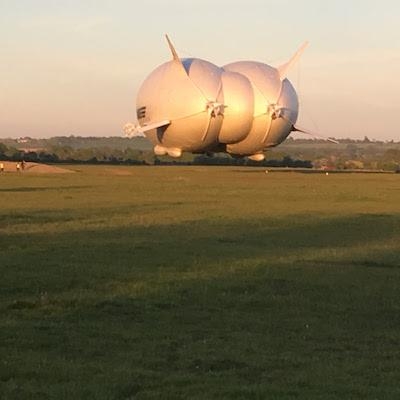Fri, May 12, 2017
Most Recent Flight Test Occurred May 10
The Airlander 10 resumed flight testing on Wednesday, May 10. All objectives of the planned flight were accomplished and the aircraft is now safely back at its masting site. The Airlander was taken off its mooring mast at 1720 local time and took off at 1728. It flew for a total of 180 minutes before landing at 2015 and was secured safely on the mast at 2020.

"It was truly amazing to be back in the air. I loved every minute of the flight and the Airlander itself handled superbly. I am eager to get back into the cockpit and take her flying again.” - Chief Test Pilot, Dave Burns.
On board were Airlander’s two Test Pilots; Chief Test Pilot Dave Burns and Experimental Test Pilot, Simon Davies.
This test flight marked the resumption of the flight test program of the Airlander 10, which started on August 17, 2016. During each of its 3 phases, the Airlander will perform more tasks and be permitted to fly further away from its base in Cardington.
This marks the return to the skies of the world’s largest aircraft, the Airlander 10, and closes the incident in which the aircraft experienced a "heavy landing" last August. The Airlander has now flown three times in addition to a successful flight as HAV-304 during the US Army’s Long Endurance Multi-intelligence Vehicle program in 2012.

There were considerable modifications since it was the HAV-304 and the Hybrid Air Vehicles team have made a number of additional modifications since last August, the main ones visible today being a new more powerful and more manoeuvrable Mobile Mooring Mast (MMM), and the additional “landing feet” of the Auxiliary Landing System (ALS).
There were three test objectives during the flight, all of which were successfully achieved:
- To conduct a full test flight – i.e. complete a safe takeoff, flight and landing of the aircraft.
- To establish basic handling characteristics of Airlander within a well-defined flight envelope including assessment of the new ALS.
- To collect flight performance data, such as handling, airspeed and all vehicle systems, for post-flight analysis. (This increases the understanding of the aircraft’s performance, capabilities and operating envelope.)
The ALS performed as expected on landing, and the Flight Test Team were very pleased with the initial analysis of this new addition to Airlander’s landing system.
(Images provided with Hybrid Air Vehicles news release)
More News
Aero Linx: International Federation of Airworthiness (IFA) We aim to be the most internationally respected independent authority on the subject of Airworthiness. IFA uniquely combi>[...]
Ultrahigh Frequency (UHF) The frequency band between 300 and 3,000 MHz. The bank of radio frequencies used for military air/ground voice communications. In some instances this may >[...]
A Few Questions AND Answers To Help You Get MORE Out of ANN! 1) I forgot my password. How do I find it? 1) Easy... click here and give us your e-mail address--we'll send it to you >[...]
From 2019 (YouTube Edition): Learning To Paint Without Getting Any On Your Hands PPG's Aerospace Coatings Academy is a tool designed to teach everything one needs to know about all>[...]
Also: Sustainable Aircraft Test Put Aside, More Falcon 9 Ops, Wyoming ANG Rescue, Oreo Cookie Into Orbit Joby Aviation has reason to celebrate, recently completing its first full t>[...]
 ANN's Daily Aero-Linx (05.06.25)
ANN's Daily Aero-Linx (05.06.25) ANN's Daily Aero-Term (05.06.25): Ultrahigh Frequency (UHF)
ANN's Daily Aero-Term (05.06.25): Ultrahigh Frequency (UHF) ANN FAQ: Q&A 101
ANN FAQ: Q&A 101 Classic Aero-TV: Virtual Reality Painting--PPG Leverages Technology for Training
Classic Aero-TV: Virtual Reality Painting--PPG Leverages Technology for Training Airborne 05.02.25: Joby Crewed Milestone, Diamond Club, Canadian Pilot Insurance
Airborne 05.02.25: Joby Crewed Milestone, Diamond Club, Canadian Pilot Insurance




